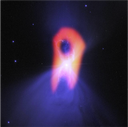The Coldest Place in the Universe
 The pre-planetary nebula, the Boomerang Nebula, is the coldest known place in the Universe, refrigerated by an expanding molecular outflow (Joule-Thomson effect), to roughly 1deg K. Planetary nebula correspond to the dying moments of Solar-analog stars, the transition from the Asymptotic Giant Branch to a planetary nebula. An HST image shows a classic double-lobed hourglass shape with a very narrow central region, expected for expanding gas outflows. ALMA CO observations show the inner double structure, but also a more spherical, high velocity outflow on large scales, and a central dust-lane of millimeter-sized grains. The HST image is most likely the result of illumination of the cold outflow material.
The pre-planetary nebula, the Boomerang Nebula, is the coldest known place in the Universe, refrigerated by an expanding molecular outflow (Joule-Thomson effect), to roughly 1deg K. Planetary nebula correspond to the dying moments of Solar-analog stars, the transition from the Asymptotic Giant Branch to a planetary nebula. An HST image shows a classic double-lobed hourglass shape with a very narrow central region, expected for expanding gas outflows. ALMA CO observations show the inner double structure, but also a more spherical, high velocity outflow on large scales, and a central dust-lane of millimeter-sized grains. The HST image is most likely the result of illumination of the cold outflow material.
Figure: The Boomerang Nebula imaged with ALMA and HST. [Blue] HST shows a classic double-lobe shape with a very narrow central region. ALMA shows a more extended CO distribution, plus a narrow dust lane in the center (Sahai ea).
View Publication: ALMA Observations of the Coldest Place in the Universe: The Boomerang Nebula, R. Sahai (JPL), W.H.T. Vlemmings (Onsala), P.J. Huggins (NYU), L.-Å Nyman (JAO, ESO), and I. Gonidakis (CSIRO), 2013 ApJ, 777, 92 (10 Nov 2013).
View 24 Oct 2013 Press Release
Added 17 Jan 2014




Connect with NRAO